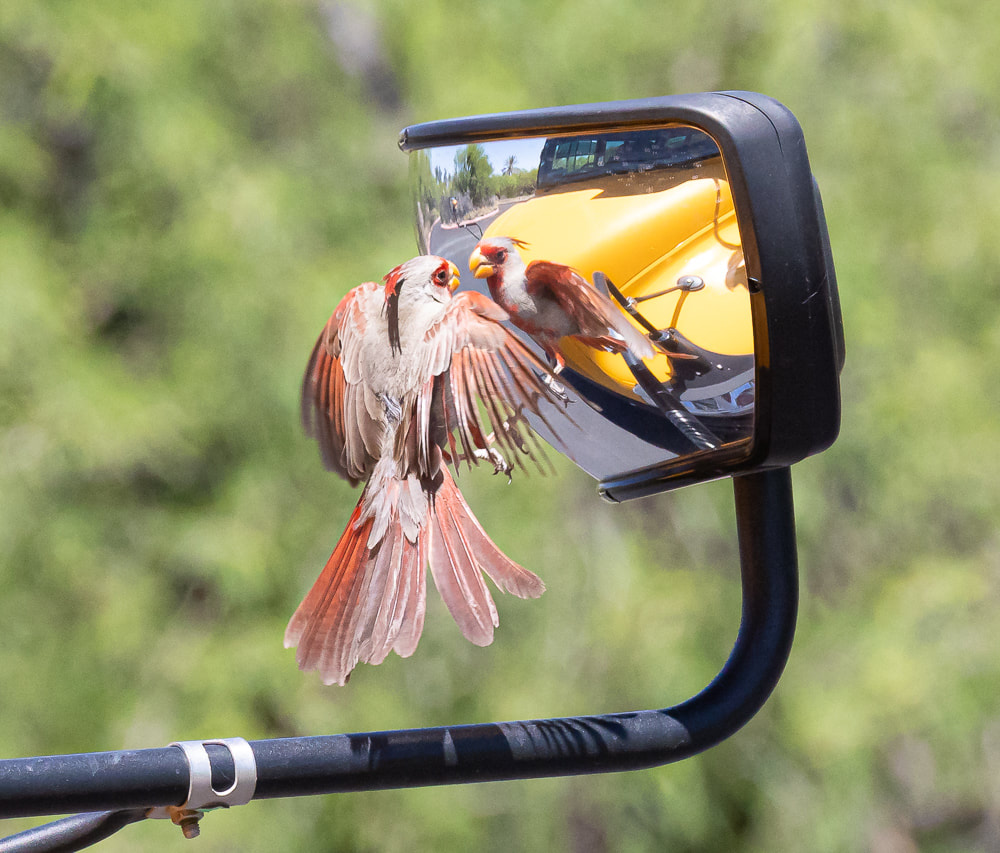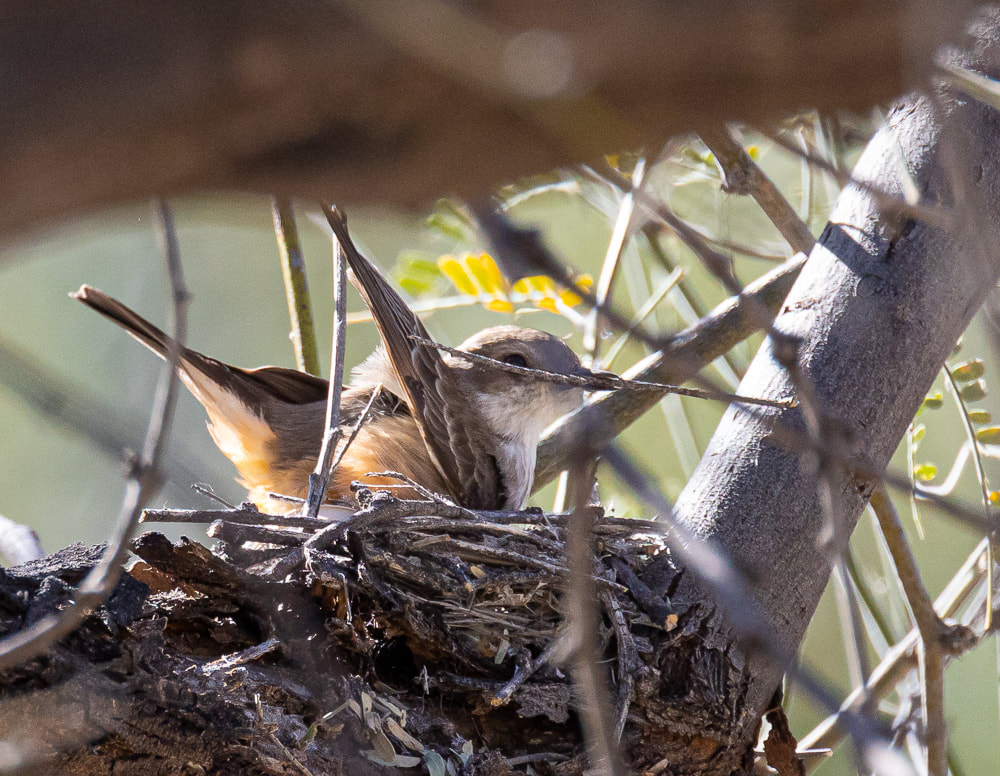|
Female Vermilion Flycatcher at her nest with one hatchling peeking out below. April 13, 2022. Canon R6, RF 100-500mm with 1.4x extender at 420 mm f/10, 1/4000 sec, ISO 5000. Birds are born to do three things: Eat, don't get eaten (get lunch before you are lunch) and make more birds. Life is pretty simple. Mom will teach you everything you need to know (or it is stored in your DNA), no degrees required. So, come spring, "making more birds" becomes the prime activity of most of the avian population. So, let's see how this plays out at one of my favorite county parks, Agua Caliente, on Roger Road, waaaaay out on the east side, east of Soldier Trail. Stake out your spot and find a mate! A Pyrrhuloxia male defends his territory.Canon R6, RF 100-500mm with 1.4x extender at 700 mm f/10, 1/4000 sec, ISO 3200. Pyrrhuloxia are songbirds of the desert southwest and Mexico, closely related to the Northern Cardinal. During the breeding season, males are fiercely territorial. Wednesday April 13th I drove into the Agua Caliente parking lot, parking on the east side, right next to the eastern stretch of Sonoran desert. To my right two spaces down was a small station wagon parked right next to the northern curb, and up against the low understory. A male Pyrrhuloxia was sitting on the car's outside right mirror, doing battle with his own image. This car, and a nearby school bus, had parked close to the bushes where this male likely has a nest with his mate, and from his perspective, in his territory. As I watched, this male went back to his bushes, where I shot the images above and below. He is clearly looking around for any other males that might intrude into his territory. He moved over to the school bus, suspicious of intruders around every corner. Here we see him perched on the right outside convex mirror. He hopped down and caught sight of his own image, an "intruder" he needed to drive away. He launches himself toward the mirror. Showing his dominance he goes on the attack, eye to eye, beak to beak. He makes himself as large as possible. "No bird is as big as I am, and no one is going to mess with me in my territory." For the photo geeks: Canon R6, RF 100-500 mm lens with 1.4 extender at 420 mm, f/10 at 1/4000 sec, ISO 5000. This shot provides a good view of his tail and wing feathers. The convex mirror allows us to see the whole bird from a frontal perspective. The background was trees of the park, off in the distance creating a nice bokeh. I shot this series at about 12 frames/second. Well, size alone didn't work, so he gets his feet out in front of him and attacks with his claws. Foot to foot combat. "No one is tougher than I am." "Whew, that was close!" He manages to scare away the intruder, and stands triumphant, at least for the time being, on top of the mirror. "Hey there, you with the camera, DON'T EVEN THINK ABOUT IT!" Our combatant eventually retired to his bush, in time both vehicles left, and peace was restored. Note that this behavior is also observed in male and female Cardinals. See All About Birds: Northern Cardinals, under the heading Cool Facts. It may be more apparent to observers among the cardinals since they have a very wide range throughout North America, and live among human populations with a host of highly reflective surfaces. We can clearly see that the Pyrrhuloxia demonstrates the same behavior. Vermilion Flycatcher nest low in a Mesquite: Progress . . . .I have been following a Vermilion Flycatcher nest low in a mesquite tree at Agua Caliente since mid-March. The image above was captured on March 18th, showing the female building her nest, a long twig in her bill. The image directly below was shot on March 27th, 9 days later, showing the male feeding the female. It is quite likely she was sitting on a clutch of eggs at that time. This feeding behavior is typical of Vermilion pairs, allowing the female to spend as much time as possible on the nest. Canon R6, RF 800mm, f/11, 1/2000 sec, ISO 4000. Canon R6, RF 100-500mm with 1.4x extender at 420 mm f/10, 1/4000 sec, ISO 5000. April 13th, the eggs have hatched, and mom is sitting above one of her hatchlings, head just evident above the edge of the nest. Below, mom sits down to protect her chicks and keep them warm. On this day I spotted two heads in the nest, but there could be more. When a Mom needs to get all her ducks in a row . . . literally!Canon R6, RF 100-500mm with 1.4x extender, 631 mm, 1/500 sec., ISO 640. If nature photography was ice hockey, Wednesday I would have scored a hat trick! A male Pyrrhuloxia deranged by hormones, a momma Vermilion keeping her chicks warm, and a female Mallard with six ducklings on the pond. These fledglings need to be out and about to eat, but mom needs to keep them moving to avoid predators that would like nothing better than duck for dinner. She kept them moving, and also moved aggressively against other ducks. In the image above four of the fledglings move quickly to keep up with mom. They are leaning forward and paddling furiously. Below, paddling on, almost in a row . . . . . That is all for now! Best wishes for a Happy Passover Holiday and a Happy Easter!
2 Comments
Donna Pierce
4/16/2022 08:05:24 am
Thanks for the fun blog. Agua Caliente Park is a favorite of mine as well. Your Pyrrhuloxia images are a real treat.
Reply
Linda Currin
4/16/2022 09:26:44 am
As always, these photos are fabulous! Thank you for sharing. Happy Easter to you and DJ!
Reply
Leave a Reply. |
AuthorHenry Johnson, photographer and author of this site. For more detail, see About
Categories
All
Archives
July 2024
|

















 RSS Feed
RSS Feed